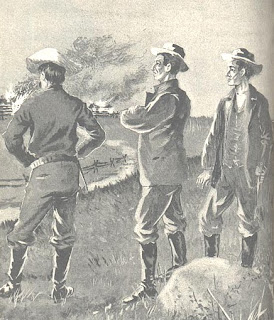Pro-slavery advocates under the leadership of Jefferson Buford had established a pro-slavery community three miles west of Osawatomie in 1856. They used their nascent community as a base for pro-slavery guerilla operations against free state advocates in the area exactly like free state advocates were using Osawatomie as a base for abolitionist guerilla operations against pro-slavery advocates in the area.
John Brown was aware of the presence of New Georgia, but he had advised against attacking the pro-slavery settlement due to his belief that if abolitionist guerilla fighters attacked the pro-slavery community, it would be the excuse that pro-slavery forces were looking for to attack Osawatomie.
However, many of the young, hotheaded abolitionist guerillas that had made Osawatomie their base of operations rejected John Brown’s cautionary warnings of the military and political inadvisability of attacking New Georgia. John Brown agreed to lead the attack on New Georgia to keep the more violent and impetuous young abolitionist guerilla fighters from committing excesses during the attack.
The abolitionist guerilla fighters surprised the pro-slavery guerillas and settlers of New Georgia completely, and they scattered to pro-slavery camps and communities in Kansas Territory and western Missouri with tales of being feloniously attacked by John Brown and a group of fiendish abolitionist guerilla fighters, which was the final straw for the pro-slavery leaders in western Missouri and Kansas Territory.
John Brown and Osawatomie had to be neutralized, and pro-slavery forces began to gather and arm themselves to attack Osawatomie and other free state communities. John Brown was indeed correct in his unheeded warnings, and the Battle of New Georgia was the final spark that caused the Battle of Osawatomie on Aug. 30, 1856.
John Brown is often portrayed as a violent fanatic who had no self-discipline about him, but the reality is that he was often the moderate abolitionist voice amongst a chorus of extremist abolitionist guerillas.
 John Brown is often portrayed as a violent fanatic who had no self-discipline about him, but the reality is that he was often the moderate abolitionist voice amongst a chorus of extremist abolitionist guerillas. Brown often had to restrain the out-of-control martial spirit of abolitionist guerillas who wanted to shoot first and ask questions later when encountering pro-slavery advocates and guerillas. It’s a facet of his personality largely overlooked in history books.
John Brown is often portrayed as a violent fanatic who had no self-discipline about him, but the reality is that he was often the moderate abolitionist voice amongst a chorus of extremist abolitionist guerillas. Brown often had to restrain the out-of-control martial spirit of abolitionist guerillas who wanted to shoot first and ask questions later when encountering pro-slavery advocates and guerillas. It’s a facet of his personality largely overlooked in history books.John Brown was certainly a militant abolitionist guerilla, but he did not participate in gratuitous impulsive violence. He only attacked militant pro-slavery advocates or those who were supplying militant pro-slavery advocates with supplies or legally protected them. When Brown did engage in violence, it was planned in advance, and calculated for the greatest psychological effect on pro-slavery advocates, not only in Kansas, but nationwide.
John Brown was considered a leader in the militant abolitionist movement because he was cool-headed in a crisis, unlike many of the young militant abolitionists who were prone to shoot first and ask questions later.--Grady Atwater
Source: "John Brown Reluctantly Led the Battle of New Georgia," The Miami County Republic [Paola, Kan.], 22 August 2018
Grady Atwater is site administrator of the John Brown Museum and State Historic Site, Osawatomie, Kansas.


